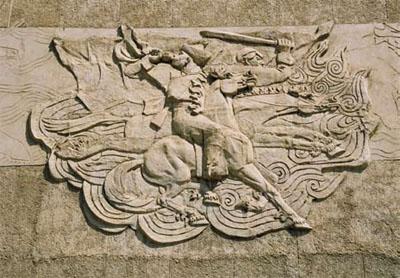All said, property price had rose but it was not as big a bubble as that in the US, and more likely only a small bubble which would be absorbed by inflation in longer terms. If the chart was wrong then the index probably remain unchanged instead of having fallen for 30% as it showed. The conclusion remains that the price is not outrageous if one did not think so in 2000.
Going forward there should be adjustment/correction given the global economic environment but the Economist is right that it is probably only a "soft landing" in China. This correction is mainly a result of international finance and trade rather than an internal bubble.
If this is true then the recent turmoil in the world actually works to China's favour, provided it does not worsen from today's level. It provides a "soft landing" to the overheated economy, corrects the inflated commodity market, and eases the inflation pressure (though this one may not really be good) for China.
China's economy Domino or dynamo?
China is pretty well placed to cushion a global downturn
CHINA has become the main engine of the world economy, accounting for one-third of global GDP growth in the first half of this year. Will it keep humming? Compared with many other emerging economies, notably Brazil and Russia, which have recently suffered big capital outflows, China has so far largely shrugged off the global credit crunch. But there are signs that China’s economy is sputtering. Export volumes have slowed markedly; the growth of industrial production dropped to a six-year low in the 12 months to August; car sales fell by 6% in the same period; and China’s property boom seems to be turning to bust.
Some of the recent slowdown reflects the temporary closure of factories around Beijing during the Olympic games, which cleared the air but made China’s statistics even hazier than usual. Yet the underlying economy has also weakened, especially in the housing market. Property sales in big cities have shrunk by around 50% over the past year. In Shenzhen prices of new luxury apartments have fallen by up to 40%. Average prices nationwide have started to slide, although they were still up by 5.3% in the year to August. Falling sales and a rising stock of new homes mean that prices are set to decline in more cities in 2009.
Predictions that average house prices could fall by up to 50% have recently grabbed the headlines. But they seem much too gloomy. After all, there has been no nationwide house-price bubble. Since 2000 average home prices have actually decreased relative to average incomes, in contrast to the surge in America until 2006 (see chart). As a result, average home prices are unlikely to fall for long.
China’s banks should also be able to withstand falling house prices better than their American counterparts. In America it was easy to get a mortgage for 100% or more of the value of a home, but Chinese buyers must put down a minimum deposit of 20-30%, depending on the home’s size, and as much as 40% on second homes. This provides banks with a large buffer as prices fall. Loans to property developers are riskier and banks’ profits will be hurt as developers go bust. But according to Wang Tao, an economist at UBS, these loans account for only 7% of total bank lending.
More generally, China’s banks should be better insulated from the global credit crunch than Western banks because the country’s system is funded through deposits rather than capital markets. Chinese banks’ loans amount to only 65% of their deposits, compared with far higher ratios in America and western Europe.
A fall in house prices will in any case hurt Chinese consumers much less than their American counterparts because Chinese households are not up to their necks in debt. Total household debt amounts to only 13% of GDP, against 100% in America. Chinese consumer spending actually strengthened this summer, with retail sales rising by 17% in real terms in the year to August. The main impact of the property downturn will be to depress construction.
The government also has room for manoeuvre. Inflation, which had been its main concern, fell to 4.9% in the year to August from 8.7% in February. This was largely thanks to lower food prices, but the growth in money supply has also slowed. Goldman Sachs forecasts that inflation will fall to 1.5% in 2009, which gives the central bank scope to ease monetary policy. Interest rates were cut for the second time in a month on October 8th, to 6.9%, and the government is expected soon to ease credit controls, especially for property.
China’s GDP growth slowed to an annual rate of a mere 10.1% in the second quarter of this year, from 12.6% a year earlier, and most economists expect it to drop to 8-9% in 2009. But this slowdown should partly be welcomed, because the economy had been exceeding its speed limit for several years. Better still, China’s growth next year will come entirely from domestic demand, as its trade surplus shrinks. If the global downturn forces China to switch the mix of growth from exports to consumption, it would also help to make its future growth more sustainable.
The government is expected to supply a fiscal stimulus to keep growth above 8%. The package will include tax cuts and extra infrastructure spending. Economists are also urging increased spending on social welfare to encourage consumers to save less and spend more. China has ample room for a stimulus because it boasts the healthiest fiscal position of any big economy. According to Stephen Green, an economist at Standard Chartered, it has a budget surplus of 2% of GDP, if measured in the same way as in rich economies, and public-sector debt is a mere 16% of GDP. China’s readiness to use fiscal lubrication is the best reason for hoping that its economic motor will not stall.









